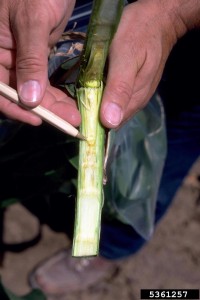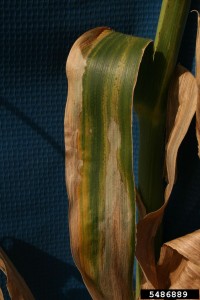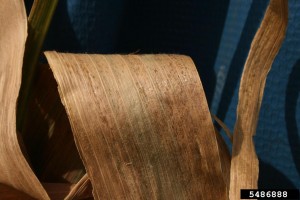Goss’s Wilt Confirmed for First Time in 2014 in Wisconsin
Damon Smith, Extension Field Crops Pathologist, Department of Plant Pathology, University of Wisconsin-Madison
This week the University of Wisconsin Plant Disease Diagnostic Clinic confirmed Goss’s wilt in dent corn from Grant County in Wisconsin. Goss’s wilt has been confirmed in past years in Wisconsin, but this is the first confirmation of the disease for the 2014 season.
Symptoms and Signs
Goss’s wilt is caused by the bacterium Clavibacter michiganensis subsp. nebraskensis. First visual symptoms usually appear as gray or yellow stripes on leaves that tend to follow the leaf veins (Fig. 1). Often “freckles”, or brown or green irregular spots, can be observed within the leaf lesions (Fig. 2). Freckles are an excellent diagnostic symptom to confirm Goss’s wilt. Vascular tissue (Fig. 3), husks, and kernels can sometimes take on an orange hue. Occasionally, bacterial ooze or dried ooze can be observed on symptomatic leaves.
Factors that Cause Disease Development
The Goss’s wilt bacterium overwinters in old corn residue. The bacterium enters the plant through wounds or natural openings. Yield losses will depend on the susceptibility of the hybrid being grown. Factors that put corn fields at higher risk include:
- Reduced Tillage
- Continuous corn rotation
- Planting a susceptible hybrid
- Hail, wind, or severe weather events causing injury on corn plants

Figure 3. Orange vascular tissue of a corn plant with Goss’s wilt. Photo credit: Howard F. Schwartz, Colorado State University, Bugwood.org.
Management
There is currently no research-based method of in-season management of Goss’s wilt. There are some foliar products being marketed for the control of Goss’s wilt, but no efficacy data are currently available. Because this disease is caused by a bacterium, the application of fungicide will not control the disease. Planting resistant hybrids in fields with a history of Goss’ wilt is recommended. Residue management and crop rotations should also be implemented in at-risk fields.
Additional Goss’s Wilt Information
University of Nebraska – http://pdc.unl.edu/agriculturecrops/corn/gosswilt
Purdue University – https://www.extension.purdue.edu/extmedia/bp/BP-81-W.pdf
Reference
L.E. Claflin. Goss’s Bacterial Wilt and Blight, in: Compendium of Corn Diseases, 3rd edition. Ed. D.G. White. APS Press.




